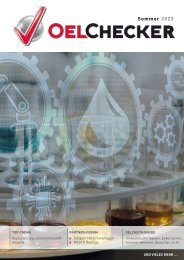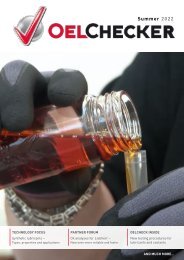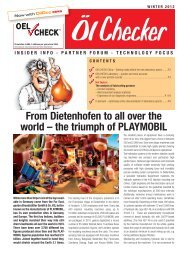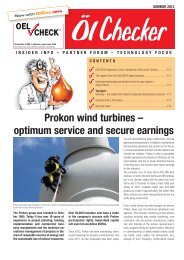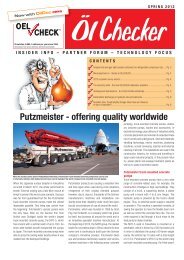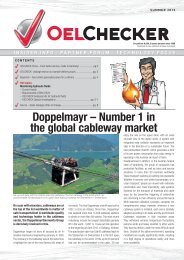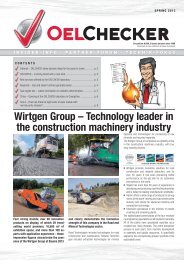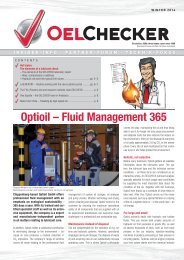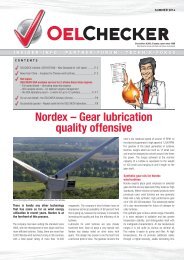OELCHECKER - Spring 2014
> Hako GmbH: Citymaster, sweeping for more cleanliness > OELCHECK laboratory technicians achieve LLA certification > Latest test equipment in the OELCHECK laboratory > News from China – Scania extends service life for HGV motor oils > HEW – Gas engines have run for 25 years without damage > Hot Topics: New lubricant, improved performance? > Decision criteria when changing lubricants > Practical procedure when changing oils > Special features of lubricating greases > Control measures after changing lubricants > LEIPA - world-leading with quality products based on scrap paper > Q & A – The time factor when sampling correctly
> Hako GmbH: Citymaster, sweeping for more cleanliness
> OELCHECK laboratory technicians achieve LLA certification
> Latest test equipment in the OELCHECK laboratory
> News from China – Scania extends service life for HGV motor oils
> HEW – Gas engines have run for 25 years without damage
> Hot Topics: New lubricant, improved performance?
> Decision criteria when changing lubricants
> Practical procedure when changing oils
> Special features of lubricating greases
> Control measures after changing lubricants
> LEIPA - world-leading with quality products based on scrap paper
> Q & A – The time factor when sampling correctly
Create successful ePaper yourself
Turn your PDF publications into a flip-book with our unique Google optimized e-Paper software.
SPRING <strong>2014</strong><br />
Circulation: 9,500; 3 issues a year since 1998<br />
Download at www.oelcheck.de/news-downloads<br />
CONTENTS<br />
OELCHECK laboratory technicians achieve LLA certification ...................... p 3<br />
Latest test equipment in the OELCHECK laboratory ................................... p 3<br />
News from China – Scania extends service life for HGV motor oils.............. p 3<br />
HEW – Gas engines have run for 25 years without damage ....................... p 4<br />
Hot topics: New lubricant, improved performance?<br />
– Decision criteria when changing lubricants<br />
– Practical procedure when changing oils<br />
– Special features of lubricating greases<br />
– Control measures after changing lubricants ...................................... pp 5-7<br />
Q & A – The time factor when taking samples correctly ............................. p 8<br />
Hako GmbH: Citymaster,<br />
sweeping for more cleanliness<br />
that the machines and their design must be highly<br />
energy efficient until they are no longer in use.<br />
Economical diesel engines with exhaust after-treatment<br />
systems in line with the most recent legislation<br />
facilitate an economical and environmentally<br />
friendly operation. Machines fitted with an ECO<br />
mode also reduce energy consumption and waste<br />
gas emissions without a significant reduction in<br />
performance.<br />
The Citymaster 2000 in action<br />
Modern and environmentally friendly, multifunctional<br />
technologies with an all-inclusive,<br />
one-stop service – that‘s what Hako<br />
is all about. Whether it‘s road sweepers for<br />
thorough outdoor cleaning, articulated, multifunctional<br />
equipment carriers for all-season<br />
use or compact equipment carriers and<br />
transporters with three attachment points<br />
and up to 300 attachments, Hako municipal<br />
cleaning technology offers individual<br />
solutions for reliable and cost-effective city<br />
cleaning and property, grounds and sports<br />
field care through to winter services.<br />
Cleaning solutions<br />
marked by environmental efficiency<br />
Hako closely complies with all legal environmental<br />
requirements when developing all its products. Furthermore,<br />
Hako attaches a great deal of importance<br />
to ensuring that products remain efficient throughout<br />
their entire life-cycle. This combination means<br />
Particularly effective gears transfer the performance<br />
to the streets with low loss. Intelligent drive<br />
controls allow hydrostatically powered machines to<br />
save as much fuel as possible when driving. In addition,<br />
in order to keep total energy consumption as<br />
low as possible during use, all products are fitted<br />
with a particularly efficient hydraulics system that<br />
meets technical requirements.<br />
Extensive service offer<br />
Hako offers an extensive service offer across all of<br />
its high-quality products that is geared towards the<br />
customers‘ needs. This includes computer-supported<br />
efficiency calculations and fleet management<br />
solutions, as well as financing and purchasing alternatives<br />
or ensuring maximum machine availability,<br />
for which in Europe alone there are approximately<br />
650 service technicians available around the clock.
This means that customers are protected in all<br />
respects by the Hako support services: they guarantee<br />
fully calculable maintenance costs, comprehensive<br />
machine protection, as well as maximum<br />
availability of the used cleaning technology. This<br />
means that a Hako maintenance agreement with<br />
individual and usage-dependent maintenance fees<br />
offers many advantages, for example. Instead of<br />
following rigid maintenance plans, equipment is inspected<br />
according to a specific maintenance matrix<br />
depending on device use.<br />
Maintenance is usually carried out on site by the<br />
customers; however, if extensive maintenance work<br />
is needed, it is performed in our own specialised<br />
workshops.<br />
Oil change intervals extended<br />
Citymasters, a part of Hako‘s municipal technology<br />
range, are hydraulically powered. Depending on the<br />
machine type, the filling level is between 50 and<br />
70 litres of ISO-VG 46 hydraulic oil. When choosing<br />
the oil, Hako opted for an energy efficient HVLP 46<br />
hydraulic fluid. This is because it protects against<br />
wear and tear, can be filtered well and has a high<br />
viscosity index and therefore has an ideal viscosity<br />
to temperature ratio. This particularly pays off when<br />
temperatures fluctuate greatly and in extreme cold.<br />
If a Citymaster is working in ecologically sensitive<br />
areas, an HEES 46 hydraulic oil is used as it can<br />
biodegrade quickly.<br />
Previously, Citymaster oil needed to be changed<br />
after 1,000 operating hours.<br />
The high-quality hydraulic oil and modern design<br />
used by Hako are, however, considerably more<br />
efficient. The perfect oil condition and system<br />
purity after 1,000 and 2,000 operating hours can<br />
be checked using the hydraulic oil analyses in the<br />
OELCHECK laboratory.<br />
These analyses document that everything is in order<br />
and that, on this basis, oil change intervals can be<br />
extended to 3,000 operating hours. Sparing two oil<br />
changes saves resources and the environment, and<br />
reduces costs.<br />
Extensive investigations were carried out into used<br />
oils in the OELCHECK laboratory before Hako decided<br />
to extend the oil service life. The results were<br />
<br />
A<br />
picture<br />
often says more than a thousand words! The photo of<br />
our laboratory technicians on the opposite page proves this!<br />
You can immediately see that this team works together! After<br />
having already had the diagnosis engineers‘ knowledge as Certified<br />
Lubrication Specialists (CLS) confirmed by the Society of Lubrication<br />
Engineers (STLE) at the turn of the year, our laboratory, technical assistance<br />
and sampling employees have now proven their knowledge<br />
on an international test bench. Together, under the management of<br />
Rüdiger Krether, Managing Director of OilDoc GmbH, they prepared<br />
for the ISO-certified Laboratory Lubricant Analysts I (LLA I) and Machinery<br />
Lubricant Analyst (MLA I) examinations in accordance with<br />
the regulations of the International Council of Machinery Lubrication<br />
(ICML) over 24 weeks. In this task it was important to combine different strengths, to help your colleague<br />
regardless of age and origin, to motivate themselves and each other and to hold the emerging<br />
nervousness in check before the examination.<br />
One thing was clear to everyone from the beginning: we can do it! We will all pass the test!<br />
Success proved them right. And in succeeding they not only obtained a certificate – the shared<br />
experience of learning and success brought the entire team closer together. This also benefits<br />
them in their everyday work in their departments. All of them are even more motivated and fully<br />
committed to their work.<br />
The joy we got from passing the test was immense and contagious! Employees from other departments<br />
celebrated with the candidates. We at OELCHECK are a strong team that can achieve great<br />
things together!<br />
Yours, Barbara Weismann<br />
analysed by Hako and assessed by experts. On<br />
this basis it is clear that extending the oil change<br />
intervals does not limit machine availability. However,<br />
OELCHECK laboratory investigations are also<br />
carried out at 1,000 operating hour intervals.<br />
The OELCHECK system is already well known to<br />
the Hako employees. Therefore, Hako does not just<br />
use the analyses for hydraulic oils. Diesel engine<br />
oils have already been analysed, too. The results<br />
provide extensive information on the condition of<br />
the engines with regard to dust exposure and fuel<br />
quality.<br />
A special Hako analysis set is now used for inspecting<br />
hydraulic oils, which contains the ideal scope of<br />
investigation for both the standard and bio hydraulic<br />
oils. The analysis set allows the oil condition, such<br />
as oxidation, additive decomposition and viscosity,<br />
wear and impurities, such as, for instance, silicon<br />
(dust) and water, to be examined. Furthermore, particles<br />
and their sizes are counted and purity classes<br />
are determined. Monitoring in this way means that<br />
any impurity in the oil during the 3,000 operating<br />
hours is discovered.<br />
Samples are taken on site by Hako service technicians.<br />
They send the sample containers directly<br />
to the laboratory in Brannenburg. Every vehicle is<br />
entered into the large OELCHECK database with<br />
its identification number. Over time, this allows<br />
for extensive documentation to be compiled for<br />
each device. Furthermore, Hako has immediate<br />
access to all data via the customer portal<br />
www.laborberichte.com.<br />
About Hako GmbH:<br />
For a good 65 years the Hako name has been synonymous<br />
with quality, reliability, service and innovative solutions.<br />
Today, with its registered office in Bad Oldesloe and branches<br />
in 15 countries across the world, the Hako Group is<br />
amongst the leading machinery manufacturers on the global<br />
market for industrial, building and outdoor cleaning, as well<br />
as for property care and winter services. The company supplies<br />
customers from around the globe with its cleaning machines,<br />
multifunctional equipment carriers and transporters.<br />
2<br />
Further information: www.hako.com
OELCHECK INSIDER INFO<br />
Our laboratory technicians are certified<br />
Laboratory Lubricant Analysts!<br />
Congratulations to our wonderful team!<br />
An in-service course over 24 weeks and an examination<br />
with 100 multiple choice questions – 16 of<br />
the OELCHECK laboratory technicians have worked<br />
flat out over the last few months! And in the end all<br />
of them achieved certification as Laboratory Lubricant<br />
Analysts I, in accordance with ISO 18436-5!<br />
The LLA I certification examination is taken before<br />
the International Council for Machinery Lubrication<br />
(ICML). ICML is an independent, non-profit organisation<br />
that was founded in order to establish the<br />
machine lubrication sector as its own technical<br />
field. Certification as an oil analysis specialist (MLA<br />
II) according to ISO 18436-4 is one of the ICML‘s<br />
best-known qualifications. The OilDoc academy<br />
has been working with the ICML for many years,<br />
carrying out the necessary preparatory courses<br />
and offering the chance to take the certification<br />
examination in German. And this is exactly what<br />
the OELCHECK laboratory have in their sights as<br />
their next challenge! They aim to be MLA II in <strong>2014</strong>.<br />
NEW<br />
Our Laboratory –<br />
always state of the art<br />
In recent weeks, two important pieces of equipment<br />
have been brought up-to-date with the latest<br />
technology. In order to be able to examine all samples<br />
as quickly as usual despite the ever increasing<br />
number, we have installed the new RULER View<br />
and the MPC iLab 475. Both pieces of equipment<br />
from Fluitec are significantly more user-friendly<br />
than their previous models. Data management and<br />
transfer has been optimised and they can be adjusted<br />
even better to conditions required by specific<br />
lubricant samples.<br />
RULER stands for Remaining Useful Life Evaluation<br />
Routine. The term „remaining useful life“ makes it<br />
clear that the RULER device can determine the period<br />
in which the oxidation of the lubricant can still<br />
be reliably prevented by the antioxidants added to<br />
the oil or lubricating grease. Predominantly, highly<br />
polluted lubricants, such as turbine oils, gear oils,<br />
compressor oils, gas engine oils, circulating lubricants<br />
and heat transfer oils, are tested.<br />
The MPC test, the Membrane Patch Colorimetry<br />
test, detects the danger of deposits in turbines and<br />
oil circulation systems. Aging products can form or<br />
impurities can get into the system during the long<br />
periods in which the oils are used. The MPC test is<br />
the only investigation method in the world that can<br />
not only detect the insoluble oil residues, but also<br />
quantitatively evaluate them.<br />
在 做 什 么 NEWS FROM CHINA 在 做 什 么<br />
Overcrowded streets and a high level of air<br />
pollution – China‘s citizens are sick and tired<br />
of the bad atmosphere.<br />
At this year‘s meeting of the National People‘s<br />
Congress, the government defined solving the environmental<br />
problem as the main task for the near<br />
future. Increasing the oil change intervals for motor<br />
vehicles is a small but important part of this. In<br />
China, currently motor oil in private cars is changed<br />
on average every 7,500 km, and for utility vehicles<br />
this figure is between 10,000 and 30,000 km. In<br />
Germany, the oil service life is, however, around<br />
30,000 km for private cars and 120,000 km for<br />
utility vehicles. This substantial difference is based<br />
on fuel qualities in the large Middle Kingdom that,<br />
up to now, have been relatively poor and varied<br />
greatly depending on region. However, not least<br />
thanks to increasing environmental awareness,<br />
the trend is moving more and more towards better<br />
fuels that contain less sulphur. At the same time,<br />
more modern, higher quality lubricants are increasingly<br />
being used.<br />
High time, then, to rethink old habits and to<br />
increase oil usage times. After all, this saves<br />
the environment and plenty of money. Utility vehicle<br />
owners are also interested in this. Scania has<br />
taken on a pioneering role in this and, with the<br />
support of OELCHECK China, is exploring what oil<br />
change intervals make sense for Scania HGVs and<br />
busses. Field tests for the Scania HGVs with their<br />
heavy diesel engines currently show that a service<br />
life of up to 80,000 km does not appear to be a<br />
problem. Because the fuel is still of relatively poor<br />
quality in some cases and the operating conditions<br />
are often difficult with extreme traffic jams in the<br />
large cities, for the time being it is recommended<br />
that oil change intervals only be extended with<br />
accompanying oil analyses in accordance with<br />
the OELCHECK analysis set 2. However, the first<br />
steps have been taken. And the examination of oils<br />
from private petrol engines that have been carried<br />
out so far show that significantly longer oil change<br />
intervals of up to 20,000 km could also be implemented<br />
in China<br />
without a hitch.<br />
3
OELCHECK PARTNER FORUM<br />
The HEW gas engines have run<br />
without damage for 25 years<br />
Electricity, gas, water, long-distance<br />
heating – HEW HofEnergie+Wasser<br />
GmbH supplies the citizens of Hof, a city<br />
in the north of Bavaria, with the four<br />
classic utilities and many additional<br />
services. HEW is a subsidiary company<br />
of Stadtwerke Hof GmbH and supplies<br />
district heating directly to the home. To<br />
use the environmentally friendly district<br />
heating, thermostats in the home need<br />
only be set to the desired temperature.<br />
District heating is economically and ecologically<br />
sound. With better efficiency levels than decentralised<br />
heat production, this form of heating can be<br />
adjusted to any changing need, is stable in terms<br />
of price and does not require lots of maintenance.<br />
Water which reaches the customers via a pipe system<br />
generally acts as the heat carrier. There, the<br />
hot water delivers heat in the heat exchangers to<br />
heat or warm water. The cooled water then flows<br />
back to the heating station where it is heated again.<br />
The district heating supply is therefore no different<br />
from a large central heating system. However, this<br />
way allows whole city districts to be supplied with<br />
ready-to-use heat, rather than just a single building.<br />
HEW operates seven combined heat and power<br />
stations (CHP stations) in different city districts,<br />
each with a manageable district heating supply<br />
network. There are 11 natural gas modules and one<br />
microgas turbine being used in total. The power of<br />
the natural gas powered engines is simultaneously<br />
used to run the generators to produce electricity.<br />
This power/heat coupling allows up to 90% of the<br />
natural gas to be used and at the same time 160<br />
million kWh electricity to be generated a year at the<br />
same time.<br />
The first CHP station was commissioned in Hof in<br />
1989 with an electrical output of 920 kW. And from<br />
then on, the first customers were supplied with<br />
district heating. The further six CHP stations were<br />
installed one after the other until 2005. HEW is<br />
celebrating the 25 th anniversary of district heating<br />
in <strong>2014</strong>!<br />
HEW is in the lucky position of having a highly<br />
motivated team who „think outside the box“ which<br />
is very important when operating combined heat<br />
and power stations. Its employees also service the<br />
nine GE Jenbacher modules each with an average<br />
electrical output of approx. 530 kW, the MTU onsite<br />
energy modules with 230 kW and the Vaillant<br />
modules with 5 kW, as well as a microgas turbine<br />
with 30 kW. A modernisation programme has been<br />
Since then, the experienced and highly motivated HEW HofEnergie+Wasser GmbH team has also carried out<br />
maintenance work at third party plants.<br />
running since 2009 due to the age of the systems.<br />
So far six of the nine GE Jenbacher and the MTU<br />
aggregate have been swapped for new modules<br />
from the respective manufacturers with an almost<br />
equal power rating. The rest of the aggregate are to<br />
be modernised in <strong>2014</strong>.<br />
Generally, a large inspection is due every 30,000<br />
to 34,000 operating hours and the motor must be<br />
swapped after approximately 60,000 operating<br />
hours. However, the modernisations of past few<br />
months meant that these works could be avoided<br />
recently. Nevertheless, oil changes of course could<br />
not be dispensed with. Each module requires<br />
approximately 230 litres of SAE 40 low-ash gas<br />
engine oil. Due to the constant operating conditions<br />
when using natural gas, it is changed at fixed<br />
intervals and the oil service life is not completely<br />
exhausted.<br />
Dipl.-Ing. (FH) Gaby Siliaz, group leader for construction<br />
and operation of the heat generation plant<br />
and CHP system: „Our philosophy has proven to<br />
be successful over the years. We have had no engine<br />
failures in 25 years! Being better able to plan<br />
maintenance during fixed oil change periods also<br />
means that personnel can be deployed in the best<br />
way possible. However, we also take samples that<br />
we send to OELCHECK to be analysed during every<br />
oil change. This means that should there be a claim<br />
we can prove, for example to the insurer, that we<br />
have completely monitored operation – the entire<br />
OELCHECK system is one unit. From sampling with<br />
tubing, vials, labels and mailers through to the lab<br />
report, which summarises the values in a manner<br />
that is easy to understand. The operator, who is<br />
an oil expert in the rarest cases, can quickly get<br />
an idea of the condition of the engine. We usually<br />
receive the results on the second working day after<br />
the sample is taken.“<br />
The values for wear, oil oxidation and base number<br />
in the OELCHECK lab reports are particularly important<br />
for the HEW employees. The latter indicates<br />
the content of alkaline additives in the oil and provides<br />
information on how many acidic components<br />
can still be neutralised and rendered harmless by<br />
the oil. The parameters acid number and i-pH value,<br />
which are necessary due to the greatly fluctuating<br />
gas composition for landfill gas engines, only then<br />
play a role if biomethane is added to the natural<br />
gas – as is often common practice today.<br />
Ultimately, however, the diagnosis engineer‘s<br />
comment is crucial. Each OELCHECK lab report is<br />
issued with one. These substantiated comments<br />
were also very important criterion for the HEW employees<br />
when choosing OELCHECK as the analysis<br />
laboratory.<br />
Gaby Siliax: „Our oldest analysis by OELCHECK<br />
dates back to 1993, by the way! We unfortunately<br />
searched for it in vain in our records, but we struck<br />
it rich with the customer portal www.laborberichte.<br />
com! Back then the gas engine oil was checked at 5<br />
week intervals and Dipl.-Ing. Peter Weismann gave<br />
the oil the go-ahead for recycling in his comment.“<br />
www.stadtwerke-hof.de<br />
4
OELCHECK TECHNOLOGY FOCUS<br />
New lubricant,<br />
improved performance?<br />
Changing your lubricants as easily as changing your shirts – that would be a fine thing! We would buy oils and greases based<br />
purely on price, simple storage and immediate availability and it would all run like clockwork. But unfortunately the necessary<br />
operating materials are not always that easy to change. Even if two products fulfil a certain specification, changing the lubricating<br />
oil or grease type can give rise to nasty surprises. Some lubricants with which positive experiences were made in Europe also<br />
bear the same designation in other countries. But their content and their effects on the lubricated components can vary greatly<br />
depending on the place of production. It‘s no accident that the topic of „changing brands“ is once more a hot topic for maintainers<br />
and international lubricant experts on LinkedIn and other online forums. Using a structured procedure and compatibility analyses<br />
could mean that the risks that may arise when changing to another product could be almost eliminated.<br />
Better is the enemy of good! And we should constantly<br />
try to continually improve anything concerning<br />
machine and system lubrication. Changing the<br />
lubricant or oil brand can have many advantages,<br />
but can also carry some risks. When changing<br />
brands never forget that lubricant is an essential<br />
part of a machine. This means that such a change<br />
is always disruptive to the machine. Prudence is<br />
the better part of valour, and you should have good<br />
reasons for changing lubricants, such as:<br />
• insufficient protection against wear with the<br />
previous product,<br />
• reducing suppliers and lubricant types (storage,<br />
mix-up),<br />
• an essential reduction in costs due to lower<br />
purchase prices,<br />
• longer oil services lives or relubrication intervals,<br />
• saving energy through improved efficiency<br />
(synthetic oils, multigrade oils),<br />
• globally committing to one lubricant manufacturer<br />
for all business units,<br />
• the previous product is not longer being<br />
manufactured.<br />
You must count on it<br />
If, for example, the previous product has similar<br />
additives (concentration of additive elements, IR<br />
spectrum) and the viscosity level hardly differs, the<br />
products can usually be changed without any big<br />
surprises. Also, when a supplier or laboratory has<br />
carried out intensive tests into the harmlessness of<br />
mixing products and there is corresponding data<br />
that is confirmed there should be no problems<br />
when changing lubricant brands.<br />
In all other cases, you should however be aware of<br />
all possible undesirable side effects:<br />
• If the new lubricant is miscible but incompatible<br />
with the old one, even if they are the same<br />
viscosity, mixing them can mean that reliable lubrication<br />
is no longer guaranteed when changing<br />
lubricants.<br />
• Consequential damage, such as wear, cavitation,<br />
impaired performance against water, early<br />
no<br />
very compatible<br />
oxidation or foaming must be expected due to<br />
differing additive concentrations or altered surface<br />
tensions.<br />
• Before the oil is changed, the system is contaminated<br />
with lacquer-like and/or sludgy deposit.<br />
The dispersant additive of the new product<br />
works differently. Deposits increasingly become<br />
detached and contaminate the filters much more<br />
than previously calculated.<br />
• The new lubricant reacts differently with seals,<br />
inner coats, galvanised or nickel-plated surface<br />
coatings or filter materials.<br />
• Additive combinations can have a corrosive effect<br />
and attack metal alloys containing tin, copper<br />
or lead.<br />
• The new product is less suitable for use under<br />
specific operating and/or environmental conditions,<br />
such as extreme temperatures, impurities,<br />
chemicals, process gasses, cleaning agents, etc.<br />
• The new oil contains a lower concentration of<br />
HD or EP additives, has different viscosity index<br />
improvers or a different base oil composition and<br />
therefore does not have the same performance<br />
capacity as its predecessor.<br />
It can become really tricky when oils are mixed together<br />
that are miscible and designed for the same<br />
use but are not completely compatible with each<br />
other, such as:<br />
yes<br />
no<br />
high priority<br />
uncertain<br />
uncertain<br />
• zinc-free and zincic hydraulic or circulating oils,<br />
• oils with detergent and non-detergent properties<br />
(HLP and/or HLPD),<br />
• glycol-based synthetic oils with other synthetic<br />
oils (PG and PAO).<br />
Nevertheless, incompatible or not, risks can only<br />
be avoided through structured procedures and any<br />
analyses that indicate probable incompatibly in the<br />
first place.<br />
The path to the right decision<br />
Our decision path shown above helps you to safely<br />
circumnavigate the dangerous cliffs. The important<br />
thing is that you follow it to the letter!<br />
Alongside the data sheets and information from<br />
the lubricant suppliers, you have access to the<br />
OELCHECK Consultation Service that is supported<br />
by the analysis results.<br />
When comparing supplier specifications you should<br />
consider the following characteristic values:<br />
The OELCHECK Consultation Engineers<br />
low priority<br />
55
OELCHECK TECHNOLOGY FOCUS<br />
• For oils: viscosity and viscosity index, additive<br />
elements, flash point, density, IR comparison<br />
and base oil differences.<br />
• For greases: consistency class, element content,<br />
IR comparison, bleeding behaviour, temperature<br />
operating range, base oil/thickener types,<br />
as well as any solids.<br />
Also compare if available.<br />
• Specifications and standards such as: DIN,<br />
ISO ASTM and, for automotive products, ACEA<br />
and API<br />
• the results of mechanical testing procedures,<br />
such as FZG test, VKA (Vier-Kugel-Apparat<br />
[four ball test]), Brugger, FE8, foam testing<br />
• Approvals from engine, system and component<br />
manufacturers.<br />
In the OELCHECK laboratory, alongside the stated<br />
analysis procedures, there are other options for<br />
checking individual lubricants and their mixtures.<br />
Values exceeding the manufacturer‘s specifications<br />
from the data sheets can be determined. This<br />
includes, for example, the content of the additive<br />
elements and the composition of the additive packages,<br />
the filterability, the oxidation stability, avoiding<br />
corrosion and performance against water and if<br />
air gets into. Performance against sealing materials<br />
and surface coating must also often be estimated.<br />
A viscosity temperature profile shows whether the<br />
lubricant is suitable for use in extremely high or low<br />
temperatures. Even individual reactions with ammonia<br />
or other cooling agents, fuels, metal working<br />
oils, hydrogen sulphide or other aggressive substances<br />
can be estimated from the existing data.<br />
It often gets very exciting when a mixture of an old<br />
and new lubricant should be evaluated. We recommend<br />
that customers carry out mixtures that<br />
are easy-to-handle themselves. Then a total of five<br />
samples, one from the two fresh oils and three mixtures<br />
(at a ratio of approx. 50:50, 95:5 and 5:95),<br />
should be sent to the laboratory in the analysis set 2<br />
with the note „Compatibility Analysis“. The oils and<br />
mixtures are tempered over four hours at 60°C in<br />
the laboratory. This allows the base oils and additives<br />
in the mixtures to react together if applicable.<br />
If afterwards there is cloudiness, severe changes<br />
in colour or even deposits and peeling, the experiments<br />
are abandoned noting that the products are<br />
definitely incompatible. Fresh oils and mixtures are<br />
only investigated further if there are no major visual<br />
changes.<br />
The next step is carried out if all criteria of the new<br />
oil type have been examined by experts based on<br />
the manufacturer‘s specifications or by the laboratory<br />
and it has been ascertained that the seals and<br />
other system materials will not be impaired. The oil<br />
change associated with changing the oil and possibly<br />
rinsing and cleaning the system.<br />
Oils – drain, rinse, change<br />
• If the old and new product is very similar<br />
the oil can be changed fluently. Shortages can<br />
be supplemented with the new product even<br />
before the oil is actually changed.<br />
• If both types show greater differences,<br />
then you should also factor in the condition of<br />
the system. If it is very challenging, old or if multiple<br />
malfunctions have already occurred, the old<br />
oil must be completely drained. When doing so<br />
attention should be paid to the fact that generally<br />
more than 5% of the old oil in the system<br />
remains on the casing walls, in the bearings and<br />
sealing spaces, in the lubricating holes and the<br />
lines even during a thorough oil change that includes<br />
draining the oil at operating temperature.<br />
• If both oil types are incompatible with<br />
each other, the equipment must be rinsed before<br />
the oil is changed. Additional cleaning measures<br />
may also need to be carried out to remove<br />
sludgy and lacquer-like deposits and residual<br />
oil. Remember, residue and impurities can also<br />
hide in coolers, heating aggregates, tubing, lines,<br />
connections and filters!<br />
If the equipment needs to be rinsed before it is<br />
filled with the new oil type, the same oil type should<br />
preferably be used at a lower viscosity level (at least<br />
two ISO VG classes lower). Additional rinsing output<br />
can be achieved through warming and circulating<br />
at high speed. Do not use additional detergents to<br />
boost the cleaning effect or only use them if the<br />
operating oil still being used also contains it.<br />
Unexpected situations when changing oil types<br />
Negative reactions Particularly frequent with Possible after-effects Precautionary measures<br />
Individual elements of the<br />
lubricant separate<br />
Seals less efficient<br />
(e.g. change to structure<br />
and/or dimensions,<br />
deformation under pressure,<br />
material destruction)<br />
Old deposits and sludge are<br />
loosened by new oil<br />
Lubricant is insufficiently<br />
effective due to incompatible<br />
additives of base oils<br />
Older machines:<br />
Changing from mineral oil to<br />
lubricants containing ester,<br />
detergents, dispersants and<br />
other polar additives<br />
Older machines: Changing<br />
to a synthetic lubricant that<br />
has a significantly different<br />
aromatics content compared<br />
to the previous product<br />
Older machines: Changing<br />
from mineral oil to lubricants<br />
containing ester, detergents,<br />
dispersants and other polar<br />
additives<br />
Mixing incompatible<br />
lubricants together, their<br />
acids/bases react with<br />
one another.<br />
Internal and external leakages, insufficient<br />
lubrication as possible result<br />
Internal and external leakages, insufficient<br />
lubrication as possible result<br />
Decreased oil supply causes insufficient<br />
lubrication and accelerates wear<br />
- Sludge and other insoluble deposits<br />
form<br />
- Loss of surface tension leads to chronic<br />
problems through air getting in, foam<br />
formation and/or the formation of oil/<br />
water emulsions<br />
- Deficient oxidation stability<br />
- Corrosion<br />
- Inadequate lubricating film stability<br />
Rinse the equipment and remedy all<br />
leakages before the machine resumes<br />
normal operation.<br />
Have the new lubricant examined<br />
for compatibility with the seals in the<br />
system. Repair/replace old, worn seals.<br />
Thoroughly clean the whole system<br />
by rinsing under high pressure before<br />
refilling. Possibly use chemical cleaning<br />
additives. Possibly hydrodynamic<br />
cleaning by specialist company for<br />
large systems.<br />
Carefully drain the old oil and rinse in<br />
order to remove all residue of the old<br />
lubricant.<br />
If rinsing with the operating oil or its thinner agent is<br />
not sufficient, special chemical cleaning additives<br />
can be used. These contain, for example, calcium<br />
sulphonate, which is usually dissolved in mineral<br />
oil. A disadvantage of this method is that after<br />
rinsing, the cleaning oil that is incompatible with<br />
all lubricants must be completely removed from the<br />
system with another rinse. Hydrodynamic cleaning<br />
can be carried out as an alternative to chemical<br />
cleaning for large or tricky oil circulation systems.<br />
The procedure is based on the application of water,<br />
air and flushing oil. This is carried out, for example,<br />
by ECOL, whose employees are internationally specialised<br />
in its application and this procedure.<br />
www.ecol.com.pl<br />
Hydrodynamic cleaning of a pipeline<br />
by an ECOL employee<br />
6
Lubricating greases behave differently<br />
Lubricating greases that have proven effective<br />
for an application should not be mixed if possible.<br />
Depending on the thickening or base oil type, they<br />
can be so incompatible with one another that they<br />
even lose their structures and become extremely<br />
soft upon mixing. However, if a new grease must<br />
be chosen, the following criteria must at least be<br />
followed:<br />
• the base oil basis (mineral oil, PAO or Ester synthetic<br />
oil) must be the same.<br />
• the base oil viscosities should be a maximum of<br />
one ISO VG class different from one another. Unfortunately,<br />
this information is often very difficult<br />
to obtain from the manufacturers.<br />
• the thickener types must be compatible.<br />
• the NLGI classes and grease consistency<br />
(penetration) should be identical.<br />
The following overview shows which lubricating<br />
greases are compatible, less compatible and not<br />
compatible at all.<br />
Thickener in<br />
lubricating<br />
greases.<br />
compatible<br />
less compatible<br />
incompatible<br />
Aluminium complex<br />
Barium<br />
Calcium<br />
Calcium 12 hydroxy<br />
Calcium complex<br />
Betonite<br />
Lithium<br />
Lithium 12 hydroxy<br />
Lithium complex<br />
Polyurea<br />
Aluminium complex<br />
Barium<br />
Calcium<br />
Calcium 12 hydroxy<br />
Each lubricating grease is therefore so incompatible<br />
with at least one grease with a different thickener<br />
that damage to the lubricated components<br />
occurs within just a few days. Greases containing<br />
an aluminium or calcium complex soap or that stick<br />
to the oil using polyurea or betonite thickeners are<br />
amongst the least compatible.<br />
If incompatible greases are mixed, their structures<br />
change. This almost always results in a serious softening:<br />
the previously firm greases become „soupy“<br />
and begin to „run“. It is uncommon but lithium soap<br />
greases can also become firmer. If betonite soap<br />
Calcium complex<br />
greases are mixed with barium complex greases,<br />
base oil frequently deposit on the surface.<br />
However, even if the thickeners are compatible, it<br />
can result in difficulties with the base oils or the<br />
additives. Greases are not even compatible within<br />
a thickener group. Polyurea greases especially<br />
bleed, which can only be counteracted with extremely<br />
short lubrication intervals. Ultimately, only<br />
investigations in the OELCHECK laboratory and discussion<br />
with the diagnosis engineers can provide<br />
information on whether and how greases are likely<br />
to react with each other and which reactions can be<br />
expected when mixing.<br />
Some precautions should be taken if a lubricating<br />
grease must be changed. First check whether:<br />
• the old grease can be rinsed out of the lubrication<br />
points in a relatively large amount of the<br />
fresh grease<br />
• the bearing requires more than the minimum<br />
amounts due to its design. Otherwise undesirable<br />
high temperatures can occur when changing<br />
necessary over-lubrication due to filling losses.<br />
Betonite<br />
Lithium<br />
Lithium 12 hydroxy<br />
Lithium complex<br />
Polyurea<br />
If there are no concerns then nothing is stopping<br />
the grease change. When lubricating using<br />
a handle grease press, it is best to proceed as<br />
follows – the same for central lubrication systems<br />
or „grease cups“:<br />
• Only lubricate with the new grease if the old<br />
grease has been used as much as possible and<br />
a new lubrication interval is due, for example.<br />
• If possible, slowly put the new fat into the running<br />
bearing until the emerging grease changes<br />
in colour or consistency and the residual grease<br />
is the same as the fresh grease.<br />
• Repeat the procedure after a few hours. This<br />
means that any residue from the old product is<br />
easier to remove.<br />
• Halve the four subsequent lubrication intervals,<br />
e.g. instead every two weeks instead of monthly,<br />
over a period of four months.<br />
You should be prepared for the fact that during the<br />
change-over phase, which can last up to six months,<br />
there is a considerably higher grease consumption<br />
and that grease disposal can be problematic.<br />
After changing, check<br />
Even if everything is running smoothly after<br />
changing oil or grease types, stay vigilant!<br />
Surprises can happen to anyone!<br />
• Monitor the systems with continuing<br />
lubricant checks and analyses.<br />
When carrying out these checks pay attention<br />
to foam, cloudiness, increasing temperatures,<br />
vibrations, noticeable running noises and grease<br />
that leaks or bleeds out.<br />
• Have a lubricant analysis carried out in<br />
the OELCHECK laboratory a few operating<br />
hours (max. one week) after changing oils.<br />
This sample serves as a reference for further<br />
trend analyses and for monitoring whether there<br />
is residual oil content in the flushing oil. You only<br />
have confirmation that everything is in order if<br />
the analysis gives the green light.<br />
• And don‘t forget to use the new lubricant<br />
name!<br />
Change signs on the system, in the lubricant<br />
storage space and on the filling devices, where<br />
applicable. Correct the information in your<br />
electronic data, purchasing and monitoring programmes!<br />
It would be a shame if an error crept<br />
in further on in the procedure!<br />
7
SPRING <strong>2014</strong><br />
MASTHEAD<br />
Oilchecker - an OELCHECK GmbH magazine<br />
Kerschelweg 28 - 83098 Brannenburg · Germany<br />
info@oelcheck.de - www.oelcheck.de<br />
All rights reserved. Reproduction is only permitted<br />
after receiving our approval.<br />
Concept and text:<br />
Astrid Hackländer, Marketing & PR, 4600 Thalheim, Austria<br />
www.astridhacklaender.com<br />
Layout and design:<br />
Agentur Segel Setzen, Petra Bots, www.segel-setzen.com<br />
Photos:<br />
OELCHECK GmbH · HAKO · HEW · iStockphoto · Ecol<br />
Can the validity of an oil sample change<br />
because the wear particles suspended<br />
in the oil deposit too quickly? One of<br />
our industrial gearboxes is regularly<br />
monitored using your lubricant analyses.<br />
The last analysis suddenly showed an<br />
exceptionally low PQ value. All other<br />
values were on trend. A control sample<br />
taken a few days later showed the<br />
expected PQ index. As always, we did<br />
not take the anomalous sample from or<br />
just in front of the oil sump after a long<br />
weekend. However, the gearbox was not<br />
in operation, otherwise we have always<br />
taken the sample during operation.<br />
Could this have influenced the result?<br />
OELCHECK:<br />
The time when the sample was taken can affect<br />
certain values. It is not without reason that we advise<br />
as follows in our sampling guidelines: „During<br />
operation or just after standstill as dirt and wear<br />
particles are suspended.“ If, however, you take oil,<br />
for example, in the morning from a machine that<br />
was not in operation over the weekend or hours<br />
after a wind power station was stopped operating,<br />
the sample may not contain all information. However,<br />
the time factor not only plays an important<br />
role when taking samples. It also has a significant<br />
role in our laboratory. In order to be able to optimally<br />
carry out the visual check, the sample containers<br />
must rest upside-down for approximately<br />
15 minutes at 40°C. This allows the wear particles<br />
from the highly viscous oils to settle on the white<br />
cover seal.<br />
The sealed sample containers are also placed<br />
upside down on the particle quantifier to determine<br />
the PQ index‘. It detects magnetisable iron wear<br />
particles in the sample using its magnetic coils.<br />
While the value given in the lab report for „iron“<br />
in mg/kg only relates to particles smaller than<br />
5 µm, the PQ index provides information on all<br />
magnetisable iron particles regardless of particle<br />
size. In order to obtain a representative sample,<br />
they should always be taken as close as to when<br />
the machine is in operation as possible. However,<br />
Sinking velocity v [mm/s]<br />
2.5<br />
2<br />
1.5<br />
1<br />
0.5<br />
0<br />
30°C<br />
20°C<br />
10°C<br />
0°C<br />
Q & A<br />
Particle Sedimentation ISO VG 320<br />
(16MnCr5)<br />
0 50 100 150 200 250 300 350 400 450 500<br />
Particle diameter d [µm]<br />
some values can only be determined after a rest<br />
time. The velocity at which particles in the oil move<br />
and deposit through gravitation depends on:<br />
• the size of the particle and its density (its<br />
weight, too)<br />
• the oil viscosity, which is also temperature<br />
dependent.<br />
The velocity at which a spherical particle sinks<br />
or sediments in a liquid can be calculated using<br />
„Stoke‘s Law“. For non-spherical bodies half of its<br />
equivalent diameter is used rather than the particle<br />
radius. We have used this „Stoke‘s Law“ to<br />
obtain comparable values for the sinking velocities<br />
of metal particles in a lubricating oil.<br />
During these calculations we assumed that the<br />
metal particles are almost spherical in shape. A<br />
magnetisable chrome steel, which is typically<br />
used for gear teeth in gearboxes, was taken as<br />
the material for the particles. At approx. 8 kg/dm³,<br />
it is almost nine times as dense as the oil which<br />
is approx. 0.9 kg/dm³. The sinking velocity of<br />
particles with a diameter of 5 µm (> 4 µm smallest<br />
particle size during particle count in accordance<br />
with ISO 4406), 50 µm (just visible with the<br />
naked eye) and 500 µm (particle from a damaged<br />
aggregate) was calculated. A conventional CLP<br />
320 gearbox oil was taken as the lubricant.<br />
Depositing was calculated for temperatures of<br />
0°C, 20°C and 60°C, as can occur when taking<br />
typical samples.<br />
Steel particle<br />
size<br />
Sedimentation speeds<br />
and duration<br />
Sedimentation<br />
speed<br />
at 0°C in oil ISO VG 320<br />
5 µm 0.000018 mm/s 322 days<br />
50 µm 0.003 mm/s 2 days<br />
Sedimentation duration<br />
for 0.5m distance<br />
500 µm 0.282 mm/s 30 minutes<br />
at 20°C in oil ISO VG 320<br />
5 µm 0.000073 mm/s 79 days<br />
50 µm 0.011 mm/s 12.5 hours<br />
500 µm 1.14 mm/s 7 minutes<br />
at 60°C in oil ISO VG 320<br />
5 µm 0.00052 mm/s 11 days<br />
50 µm 0.082 mm/s 1.5 hours<br />
500 µm 8.16 mm/s 1 minute<br />
In principle, the following is true:<br />
• 5 µm particles never completely settle. Even<br />
after an aggregate has stopped, they remain in<br />
full concentration in an oil sample, regardless<br />
of how long after downtime and where the oil<br />
was taken.<br />
• 50 µm particles, which are visible to the naked<br />
eye and are counted at > 14 µm during particle<br />
counting, can fall over a distance of 0.5 m over<br />
a weekend. In this case at least a short start<br />
should take place before the sample is taken or<br />
the sample should be taken from further down.<br />
• 500 µm particles, which indicate acute damage,<br />
can sink into the oil sump in a few minutes.<br />
Depending on where the sample was taken, if<br />
the sample was only taken after a long downtime,<br />
the sample contains either too many or<br />
none at all. Such large particles, which would<br />
block the particle counter with the measuring<br />
cell cross-section of 100 µm, should not be<br />
considered in the particle count.<br />
In our laboratory the time span of 20 minutes in<br />
which the oil samples stand upside down is completely<br />
sufficient for detecting all the magnetisable<br />
particles. In return, samples should always be<br />
taken during operation or as quickly as possible<br />
after the machine stops moving. A sample can<br />
only be representative if this is done, which is necessary<br />
for or lab reports to be valid. An accurate<br />
and quick sample is therefore completely<br />
in your best interest!<br />
If you have questions about tribology or lubricant analysis, OELCHECK can answer them.<br />
Send us your questions by e-mail (info@oelcheck.de) or by fax (+49 8034-9047-47).<br />
8




